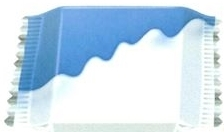Case law about distinctiveness 3d-marks applies to marks consisting of twodimensional representations of products
08-05-2017 Print this page
Case law in respect to distinctiveness of three dimensional trade marks consisting of the appearance of the product itself also applies in respect of figurative marks consisting of the two-dimensional representation of the product. General Court did not err in law in applying the case law to the present case.
36. That case-law, which was developed in relation to three-dimensional trade marks consisting of the appearance of the product itself, also applies in respect of figurative marks consisting of the two-dimensional representation of the product (judgment of 22 June 2006, Storck v OHIM, C‑25/05 P, EU:C:2006:422, paragraph 29).
37. It is apparent from the foregoing considerations that, where the issue is establishing the distinctive character of a mark consisting of the appearance of the product which it designates, it is necessary to verify whether that mark departs significantly from the standard or customs of the sector, such verification not being reserved solely to three-dimensional marks.
38. It follows that, contrary to what Storck argues, the General Court did not err in law in applying, in the present case, those principles as well as the ones which emerge from the judgment of 22 June 2006, Storck v OHIM (C‑25/05 P, EU:C:2006:422).
General Court was entitled to find that the mark representing the shape of a white, grey and blue square-shaped packaging was devoid of any distinctive character
42. In that regard, the General Court found, in paragraphs 49 and 51 of the judgment under appeal, that (i) the different colours are commonplace, such that they will be perceived by the relevant public only as being aesthetic or presentational elements, (ii) the interpretation that the figurative element in question represents a snow-covered mountain and a blue sky is not obvious to the relevant consumer, (iii) it is well known that such a pattern and a blue sky frequently appear on the packaging of products such as the goods concerned, (iv) as regards the colours used, the white part could also bring to mind milk, an ingredient commonly used in chocolates and ice-creams, which is often represented on the packaging of chocolates, and (v) the addition of an image naturally comes to mind, given that the consumer is used to the fact that coloured elements are present on the packaging of products such as the goods concerned. It is on the basis of those considerations that the General Court concluded, also in paragraph 51, that the image affixed to the mark applied for and the grey edges of the packaging were not such as to confer a distinctive character on that mark and that those elements were likely to be seen by consumers as mere decorative patterns and not as an indication of origin.
43. Consequently, as is apparent from paragraphs of 37 to 40 above, the General Court was entitled to find that the mark applied for was devoid of any distinctive character, such an assessment in relation to a two-dimensional mark containing a figurative element not being based, contrary to what Storck claims, on criteria not laid down in the case-law of the Court of Justice or too strict in relation to that case-law. It follows that the first part of the first ground of appeal must be rejected as unfounded.
IPPT20170504, CJEU, August Storck v EUIPO
C-417/16 P - ECLI:EU:C:2017:340


















